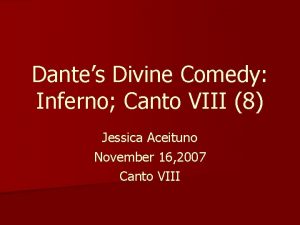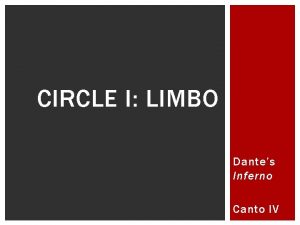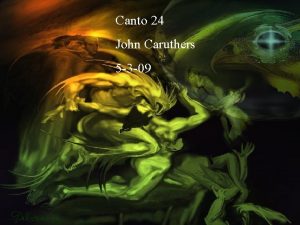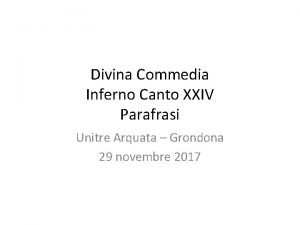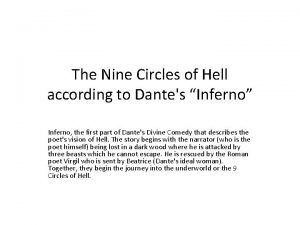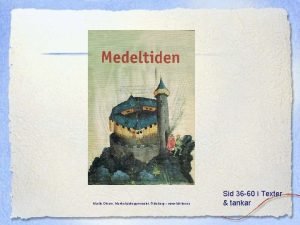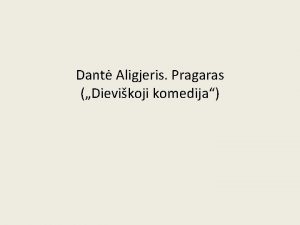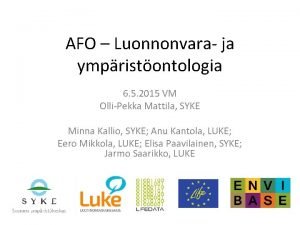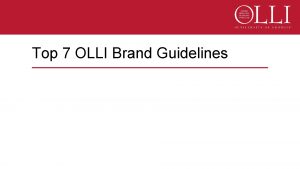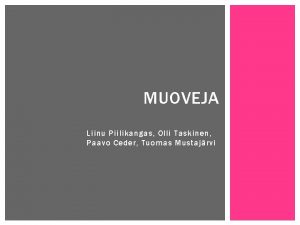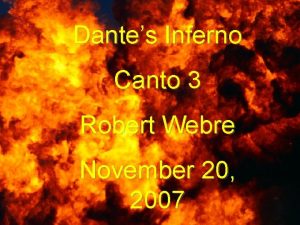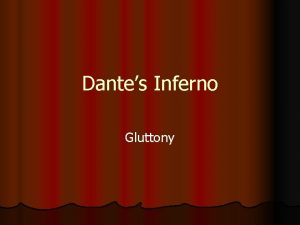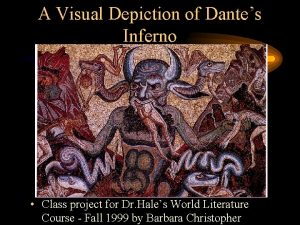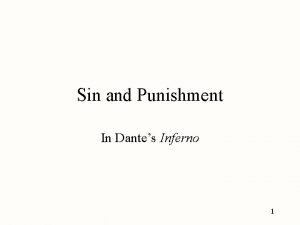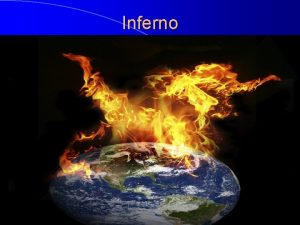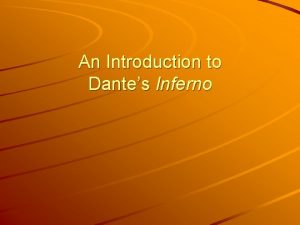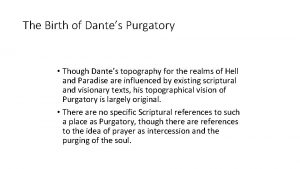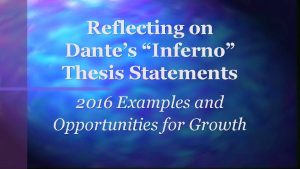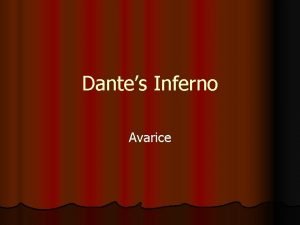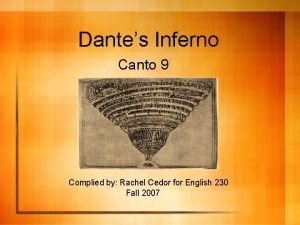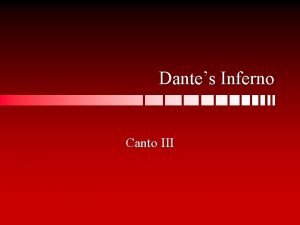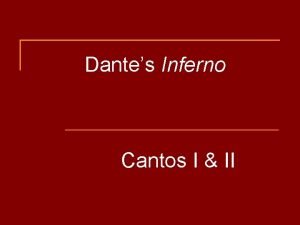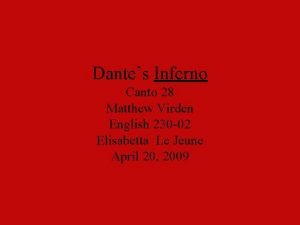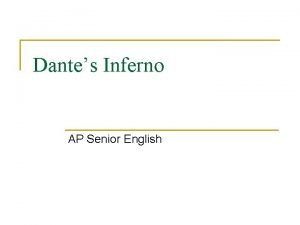Introduction to Dantes Inferno OLLI Tallwood Class One































- Slides: 31

Introduction to Dante’s Inferno OLLI Tallwood Class One: April 18, 2017 Prof. K. Olson

Benigni e Tutto Dante In his “Letter to Dante, ” Roberto Benigni tells Dante: “It was you who made me experience both good and evil, made me go to sleep frightened out of my wits, moved me to tears. . And it was you who made me die of laughter. . ” Benigni recounts the story of how, when seeing Dante’s statue in front of Santa Croce in Florence for the first time, he thought it was that of Pinocchio: “My mother as a child used to tell me: ‘If you tell lies your nose will become long like Pinocchio’s and then Dante Alighieri will send you to hell!’ Until one day in the square I saw a statue of Dante and that nose made me think he was Pinocchio. ”

Dante today, continued by Sten, Lex and Lucamaleonte ( Via Nuora, Rome)

Vergil and Dante

Who was Dante? v. Born in Florence, Tuscany, between May 11 th and June 11 th, 1265, under the sign of Gemini. Died in 1321 in Ravenna while in exile. v. Sign of Gemini: “The little threshing floor / that so incites our savagery was all – from hills to river mouths – revealed to me / while I wheeled with eternal Gemini” (Par. 21. 151 -152). v. Giovanni Boccaccio (right) was the first to write a biography of the author (“Trattatello in laude di Dante”). v. Considered the first of the “tre corone”

Dante the Pilgrim v Dante the Pilgrim would be 35 years old. v “When I had journeyed half of our life’s way”(Inf. 1. 1) ~ Psalm 89: 10, lifespan is 70 yrs. v Isaiah 38: 10: “In the middle of my days, I shall go to the gates of hell. ”

Beatrice Portinari, 12661290. Dante’s muse, whom he met when they were both nine years old (Vita nuova – New Life). Daughter of Folco Portinari, banker. Married to Simone de’ Bardi, banking family. Will be Dante’s guide from the Earthly Paradise (end of Purgatory) to the end of Paradise.

Beatrice “’Now pay attention, ’ and he raised his finger; / ‘when you shall stand before the gentle splendor / of one whose gracious eyes see everything, / then you shall learn – from her – your lifetime’s journey. ’” – Inf. 10. 129 -132

What did Dante look like? v In Boccaccio’s biography of Dante, he described his face as “long, his nose aquiline, his eyes rather large than small, his jaws heavy, with the under lip projecting beyond the upper. His complexion was dark, and his hair and beard, black, and crisp; and his countenance always sad and thoughtful. ” v. Boccaccio fashioned the way that we “view” Dante. v. Anthropological study at the University of Pisa in 2008 showed that Dante’s nose was not as aquiline. v Sepulchre in Ravenna will be opened in 2021.

Dante’s physiognomy: “Human” or “Divine”?

Dante’s ancestral line v His actual origins: born in Florence, Italy, to a noble family, the Alighieri, of humble means. His father was Alighiero di Bellincione, a White Guelph (a party that supported the papacy). v We meet his great-grandfather, Cacciaguida degli Elisei, in Paradiso 15. 135, and here and elsewhere in the Comedy he implies that he descended from the Romans (i. e. , metaphor of Anchises). v At the age of 12, Dante was promised in marriage to Gemma Donati, with whom he had at least five children (Jacopo and Piero, his sons, were also the first commentators of his poem).

The prophecy of exile "You shall leave behind all you most dearly love, and that shall be the arrow first loosed from exile’s bow. You shall learn how salt is the taste of another man’s bread and how hard is the way, going down and then up another man’s stairs. (Par. 17. 55 -60)

The Prophecy of Exile John Flaxman, 1793

What led to Dante’s exile? Choose the right answer! v He cheated on his wife with some girl named Beatrice. v He wrote the Divine Comedy and was sent into exile for its heretical claims. v He went to Rome as an ambassador and decided it was nicer than Florence. v He belonged to the political party that was opposed to the power of the papacy. v None / all of the above.

You guessed correctly! v FALSE: He fell in love with Beatrice Portinari when he was 9 years old, but their love was never consummated. Furthermore, true love only existed outside of marriage for medievals (i. e. , courtly love). v FALSE: His book De Monarchia was on the papal index from 1554 -1881. v FALSE: He traveled to Rome in October 1301 while part of a Florentine embassy.

You guessed correctly! v TRUE: He belonged to the political party that was opposed to the power of the papacy. Dante was a White Guelph who served on the Council of Priors. Charles of Valois, in November 1301, who was the right hand of Boniface, sacked Florence and overturned the Whites. v Dante was subsequently sentenced to exile from Florence in January 1302, and then permanently banned in March 1302 under penalty of death. He never returned to his native city. He would eventually leave the White Guelph party and “form a party of his own. ”

In exile

The Events that Led to Dante’s Exile Dante is the victim of the politics of the papacy and of Florence. Pope Boniface VIII is the ultimate culprit, according to Dante (“the one who plans and plots / where – every day – Christ is both sold and bought” 50 -51). Boniface empowered the Black Guelphs by the work of Charles of Valois. Together, they sent the White Guelph leaders into exile (January 27, 1302).

Dante’s exile Dante was first charged with crimes and fined 5, 000 florins. Then he was condemned (by Cante de’ Gabrielli) to two years in exile and a death sentence if he were caught in Florence. Then the order grew to include wives and male descendents. During his exile, he led a group of Ghibellines and White Guelphs that had little success. He left them and “became his own party” in 1304.


The Scala family: Host in exile from 1303 4

The poetic structure of the Divine Comedy n A “comedy, ” according to Aristotle (384 -322 BC), is a work of literature in which the protagonist experiences a reversal of bad fortune. Boccaccio gave it the modifier, “divine. ” n It consists of three canticles: Inferno (Hell), Purgatorio (Purgatory), Paradiso (Paradise). Each canticle treats one of the three realms of the afterlife.

The poetic structure of the Divine Comedy n The entire poem is written in terza rima, or “third rhyme. ” This is an interlocking rhyme designed by Dante (we believe): ABA-BCB-CDC-DED. It guards against “textual corruption, ” when scribes would modify the text during the copying of a holograph. n It is written in the Florentine Vernacular, and not in Latin. n We do not have a copy of the Divine Comedy written by Dante’s hand, but there are hundreds of copies that survive from the 14 th-15 th centuries. Giovanni Boccaccio was amongst the earliest copyists of the poem.

Dante’s Universe


Structure of Hell: Inferno 11 While getting acclimated to the stench of Hell, Vergil takes a moment to explain the structure of hell (Inf. 11. 16 -- ) Originates from Aristotle’s Nichomachaen Ethics: incontinence, mad bestiality, and malice. The three appetites of the will: Incontinence: concupiscent (circles 2 through 5) Mad bestiality: irascible (circle 7) Malice: rational (circles eight and nine)

Francesca, Inferno 5 “There is no greater sorrow / than thinking back upon a happy time in misery – and this your teacher knows. ” (Inf. 5. 121 -123)

Farinata, Inferno 10 “Your accent makes it clear that you belong / among the natives of the noble city / I may have dealt with too vindictively, ” (Inf. 10. 25 -27)

Pier della Vigna, Inferno 13 “My mind, because of its disdainful temper, / believing it could flee disdain through death, / made me unjust against my own just self, ” Inf. 13. 70 -73

Capaneus, Inferno 14 “That which I was in life, I am in death, ” Inf. 14. 51

Brunetto Latini, Inferno 15 “If you pursue your star, / you cannot fail to reach a splendid harbor, ” Inf. 15. 55 -56
 Dantes inferno levels
Dantes inferno levels Dantes inferno canto 8
Dantes inferno canto 8 Dantes inferno xxx
Dantes inferno xxx Dante inferno canto 4
Dante inferno canto 4 Canto 24
Canto 24 Dantes inferno canto 7
Dantes inferno canto 7 Writers from the renaissance
Writers from the renaissance Canto 24 inferno parafrasi
Canto 24 inferno parafrasi Lust ring of hell
Lust ring of hell Dante helvetestratt
Dante helvetestratt Pragaro ratai
Pragaro ratai Olli silven
Olli silven Olli-pekka mattila
Olli-pekka mattila Olli snellman
Olli snellman Olli lehtonen luke
Olli lehtonen luke Olli ruohomäki wikipedia
Olli ruohomäki wikipedia Olli haila
Olli haila Olli brand
Olli brand Olli komulainen
Olli komulainen Valtamuovi
Valtamuovi Olli ploeger
Olli ploeger Olli savela
Olli savela Olli-pekka varis
Olli-pekka varis Olli bräysy
Olli bräysy Olli south
Olli south One god one empire one religion
One god one empire one religion One one little dog run
One one little dog run One king one law one faith
One king one law one faith One empire one god one emperor
One empire one god one emperor One ford behaviors
One ford behaviors See one do one teach one
See one do one teach one One price policy
One price policy

